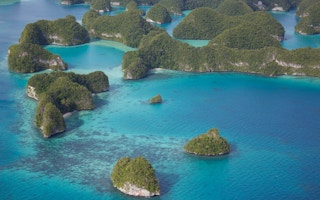The sun-drenched coral islands and reefs of the Maldives are in existential danger. With 80 per cent of the country’s population living just one metre above sea level, many islands could become uninhabitable as climate change causes the ocean’s level to rise. By the end of this century, half a million people could be displaced. The Maldives is confronting this threat with a range of innovative adaptation initiatives, from restoring coral reefs to floating solar-power systems. But survival does not come cheap.
The Maldives earns much of its revenues from high-end tourism. So, like many other countries, it was hit hard by the Covid-19 pandemic, which brought much global travel to a halt. But in 2021, when restrictions were loosened, a powerful tourism rebound fueled robust economic recovery in the Maldives, with the promise of a return to pre-pandemic growth by 2023.
That recovery was interrupted by two successive credit rating downgrades – first from Moody’s and then from Fitch – which caused borrowing costs to rise sharply. The last bonds the Maldives issued in 2021 carried a coupon rate of 9.875 per cent and a yield of 10.5 per cent. Since then, bond yields have surpassed 20 per cent – a reflection of investors’ perceptions of higher risk. As a result, the Maldives has effectively been locked out of international markets. It has not issued a bond to finance its development programs since 2021.
The Maldives isn’t alone. During the pandemic, 11 of the 16 Small Island Developing States (SIDS) – which are particularly vulnerable to climate change – that are rated faced a downgrade or a negative credit outlook by at least one of the big three credit rating agencies (CRAs): Moody’s, Fitch, and Standard & Poor’s. This is catastrophic for economic development and climate adaptation efforts.
The use of credit ratings as the ultimate measure of a country’s creditworthiness has long been recognised as a threat to financial stability, particularly in the Global South. Downgrades have an enormous impact, triggering sell-offs and market volatility at precisely the moment countries can least afford it. Yet the credit rating industry itself is neither transparent nor competitive.
A recent UNDESA study found that during the pandemic, emerging-market and developing economies’ credit ratings were downgraded by a total of 125 notches, whereas advanced economies – which both contracted and accumulated debt more rapidly – were downgraded by only six notches. This probably partly reflects the fact that the big three CRAs are largely staffed and regulated in the Global North.
Moreover, rating decisions are often shaped by ideological biases – such as the belief that government intervention in the economy automatically undermines growth and efficiency – instead of the factors that matter for debt sustainability: economic and social development, as well as climate resilience. Sovereign credit assessments capture climate-related risks indirectly, through environmental, social, and governance (ESG) scores, but efforts to build climate resilience are ignored, despite their important implications for debt sustainability.
The SIDS are among the world’s most highly indebted countries: their public-debt-to-GDP ratio averaged 82.5 per cent in 2020, and is set to remain above 70 per cent until 2025. Climate change is an important reason why. As a 2018 study by the United Nations Environment Programme showed, climate vulnerability raised the average cost of debt for a sample of developing economies by 117 basis points over the previous decade, forcing them to pay US$40 billion in additional interest payments. Some have predicted that, over the coming decade, this burden will increase by US$146-168 billion.
This would prove catastrophic for the SIDS. If these countries are to stay above water (literally), they must be able to invest in the building blocks of sustainable growth and development: people, infrastructure, energy, and food security. But their debt-servicing costs are already massive – far bigger than the limited climate finance delivered through global agreements. From 2016 to 2020, SIDS received US$9.42 billion in development and climate finance to strengthen their resilience, and paid out US$26.6 billion to external creditors.
Making matters worse, the SIDS have few options for restructuring their debts – not least because of ratings downgrades. Notably, countries participating in the G20’s Common Framework for Debt Treatments beyond the Debt Service Suspension Initiative face the threat of a downgrade. Small wonder, then, that only three eligible countries have so far applied for relief under the Common Framework. Downgrading countries while they try to renegotiate their debts – nearly half of which is held by private bondholders – amounts to a devastating blow, as it compounds the already-high barriers between them and international credit markets.
Secure, prosperous, climate-resilient states are clearly better for the rest of the world – including private creditors and advanced-economy governments – than unstable, debt-ridden countries enduring extensive human and environmental dislocation and loss. If credit ratings are to remain a market barometer, they must be made transparent, fair, and constructive.
To this end, the Office of the UN High Commissioner for Human Rights has rightly called for the suspension of credit ratings during crises. CRAs should also suspend the publication of reviews during periods of upheaval, to allow markets to adjust to changing fundamentals.
CRAs’ ideological biases and lack of transparency could be addressed by decentralising them or establishing regional or multilateral ratings agencies. Finally, CRAs should share guidance on how climate risks and adaptation efforts fit into their methodologies, particularly when it comes to rating sovereigns.
Just as the credit rating system in the United States was reformed after the 2008 global financial crisis through the Dodd-Frank Act, CRAs must be improved in response to the challenges SIDS are now facing. Plagued by fires and floods linked to a climate crisis they had no hand in creating, these countries deserve support, not punishment.
Emily Wilkinson is a senior research fellow and Director of the Resilient and Sustainable Islands Initiative at ODI, a global affairs think tank. Kanni Wignaraja, United Nations Assistant Secretary-General, is UN Development Programme Regional Director for Asia and the Pacific.
Copyright: Project Syndicate, 2023.
www.project-syndicate.org










